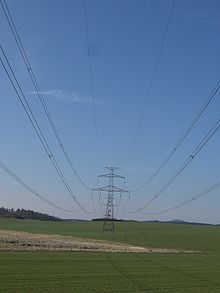- Electrical conductor
-
In physics and electrical engineering, a conductor is a material which contains movable electric charges. In metallic conductors such as copper or aluminum, the movable charged particles are electrons (see electrical conduction). Positive charges may also be mobile in the form of atoms bound in a crystal lattice which are missing electrons (known as holes), or in the form of mobile ions, such as in the electrolyte of a battery, or as mobile protons in proton conductors employed in fuel cells. In general use, the term "conductor" is interchangeable with "wire." Insulators are non-conducting materials with few mobile charges and which support only insignificant electric currents.
Contents
Physics
All conductors contain electric charges, which will move when an electric potential difference (measured in volts) is applied across separate points on the material. This flow of charge (measured in amperes) is what is meant by electric current. In most materials, the direct current is proportional to the voltage (as determined by Ohm's law), provided the temperature remains constant and the material remains in the same shape and state.
Most familiar conductors are metallic. Copper is the most common material used for electrical wiring. Silver is the best conductor, but is expensive. Because it does not corrode, gold is used for high-quality surface-to-surface contacts. However, there are also many non-metallic conductors, including graphite, solutions of salts, and all plasmas. There are even conductive polymers. See electrical conduction for more information on the physical mechanism for charge flow in materials.
All non-superconducting materials offer some resistance and warm up when during electric currents. Proper design of an electrical conductor takes into account the temperature of the conductor as well as the value of electric current. The motion of charges creates an electromagnetic field around the conductor that exerts a mechanical radial squeezing force on the conductor. The current carrying capacity of a conductor is limited by its ability to dissipate heat. This effect is especially critical in printed circuits, where conductors are relatively small and close together, and inside an enclosure: the heat produced can cause melt the tracks.
Thermal and electrical conductivity often go together. For instance the Sea of electrons causes most metals to act both as electrical and thermal conductors. However, some non-metallic materials are practical electrical conductors without being good thermal conductors.
Wire size
Wires are measured by their cross section. In many countries, the size is expressed in square millimeters. In North America conductors are measured by American wire gauge for smaller ones, and circular mils for larger ones.
Conductor materials
Copper has a high conductivity. Silver is more conductive, but due to cost it is not practical in most cases. However, it is used in specialized equipment, such as satellites, and as a thin plating to mitigate skin effect losses at high frequencies. Because of its ease of connection by soldering or clamping, copper is still the most common choice for most light-gauge wires.
Main article: Aluminum wireAluminium has been used as a conductor in housing applications for cost reasons. It is actually more conductive than copper when compared by unit weight, but it has technical problems that have led to problems when used for household and similar wiring, sometimes having led to structural fires:
- a tendency to form an electrically resistive surface oxide within connections, leading to heat cycling of the connection (unless protected by a well-maintained protective paste);
- a tendency to "creep" during thermal cycling, causing connections to become loose due to a low mechanical yield point of the aluminium; and
- a coefficient of thermal expansion sufficiently different from the materials used for connections, accelerating the creep problem and addressed by using only plugs, switches, and splices rated specifically for aluminium.
These problems do not affect other uses, and aluminium is commonly used for the low voltage "drop" between a power pole and the household meter. It is also the most common metal used in high-voltage transmission lines, in combination with steel as structural reinforcement.
The surface of anodized aluminum does not conduct electricity, and sometimes this must be considered when aluminium enclosures are to be electrically bonded for safety or to enclose or exclude electromagnetic radiation.
Conductor ampacity
The ampacity of a conductor, that is, the amount of current it can carry, is related to its electrical resistance: a lower-resistance conductor can carry a larger value of current. The resistance, in turn, is determined by the material the conductor is made from (as described above) and the conductor's size. For a given material, conductors with a larger cross-sectional area have less resistance than conductors with a smaller cross-sectional area.
For bare conductors, the ultimate limit is the point at which power lost to resistance causes the conductor to melt. Aside from fuses, most conductors in the real world are operated far below this limit, however. For example, household wiring is usually insulated with PVC insulation that is only rated to operate to about 60 °C, therefore, the current in such wires must be limited so that it never heats the copper conductor above 60 °C, causing a risk of fire. Other, more expensive insulation such as Teflon or fiberglass may allow operation at much higher temperatures.
The American wire gauge article contains a table showing allowable ampacities for a variety of copper wire sizes.
Isotropy
If an electric field is applied to a material, and the resulting induced electric current is in the same direction, the material is said to be an isotropic electrical conductor. If the resulting electric current is in a different direction from the applied electric field, the material is said to be an anisotropic electrical conductor.
See also
Categories:- Electricity
- Hardware (mechanical)
- Power engineering
- Fundamental physics concepts
Wikimedia Foundation. 2010.

